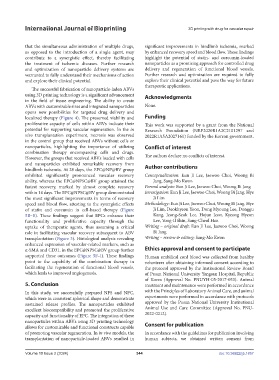Page 352 - IJB-10-2
P. 352
International Journal of Bioprinting 3D printing with drug for vascular repair
that the simultaneous administration of multiple drugs, significant improvements in hindlimb ischemia, marked
as opposed to the introduction of a single agent, may by enhanced recovery speed and blood flow. These findings
contribute to a synergistic effect, thereby facilitating highlight the potential of statin- and curcumin-loaded
the treatment of ischemic diseases. Further research nanoparticles as a promising approach for controlled drug
and optimization of nanoparticle delivery systems are delivery and regeneration of functional blood vessels.
warranted to fully understand their mechanisms of action Further research and optimization are required to fully
and explore their clinical potential. explore their clinical potential and pave the way for future
therapeutic applications.
The successful fabrication of nanoparticle-laden ABVs
using 3D printing technology is a significant advancement Acknowledgments
in the field of tissue engineering. The ability to create
ABVs with customizable sizes and integrated nanoparticles None.
opens new possibilities for targeted drug delivery and
localized therapy (Figure 4). The preserved viability and Funding
proliferative capacity of cells within ABVs indicate their This work was supported by a grant from the National
potential for supporting vascular regeneration. In the in Research Foundation (NRF2020R1A2C2101297 and
vivo transplantation experiment, necrosis was observed 2022R1A5A2027161) funded by the Korean government.
in the control group that received ABVs without cells or
nanoparticles, highlighting the importance of utilizing Conflict of interest
combination therapy encompassing cells and drugs.
However, the groups that received ABVs loaded with cells The authors declare no conflicts of interest.
and nanoparticles exhibited remarkable recovery from
hindlimb ischemia. At 28 days, the EPC@NP@BV group Author contributions
exhibited significantly pronounced vascular recovery Conceptualization: Eun Ji Lee, Jaewoo Choi, Woong Bi
ability, whereas the EPC@NPSC@BV group attained the Jang, Sang-Mo Kwon
fastest recovery, marked by almost complete recovery Formal analysis: Eun Ji Lee, Jaewoo Choi, Woong Bi Jang
within 14 days. The EPC@NPSC@BV group demonstrated Investigation: Eun Ji Lee, Jaewoo Choi, Woong Bi Jang, Hye
the most significant improvements in terms of recovery Ji Lim
speed and blood flow, attesting to the synergistic effects Methodology: Eun Ji Lee, Jaewoo Choi, Woong Bi Jang, Hye
of statin and curcumin in cell-based therapy (Figure Ji Lim, Deokhyeon Yoon, Dong Myoung Lee, Donggu
5B–E). These findings suggest that EPCs enhance their Kang, Jeong-Seok Lee, Hojun Jeon, Kyeong Hyeon
functionality and proliferative capacity through the Lee, Yong-Il Shin, Sang-Cheol Han
uptake of therapeutic agents, thus assuming a critical Writing – original draft: Eun Ji Lee, Jaewoo Choi, Woong
role in facilitating vascular recovery subsequent to ABV Bi Jang
transplantation (Figure 3). Histological analysis revealing Writing – review & editing: Sang-Mo Kwon
enhanced expression of vascular-related markers, such as
α-SMA and CD31, in the EPC@NPSC@BV group further Ethics approval and consent to participate
supported these outcomes (Figure 5F–I). These findings Human umbilical cord blood was collected from healthy
point to the capability of the combination therapy in volunteers after obtaining informed consent according to
facilitating the regeneration of functional blood vessels, the protocol approved by the Institutional Review Board
which leads to improved angiogenesis. of Pusan National University Yangsan Hospital, Republic
of Korea (Approval No. PNUYH-05-2017-053). Animal
5. Conclusion treatment and maintenance were performed in accordance
In this study, we successfully prepared NPS and NPC, with the Principles of Laboratory Animal Care, and animal
which were in consistent spherical shape and demonstrate experiments were performed in accordance with protocols
sustained release profiles. The nanoparticles exhibited approved by the Pusan National University Institutional
excellent biocompatibility and promoted the proliferative Animal Use and Care Committee (Approval No. PNU-
capacity and functionality of EPC. The integration of these 2022-0212).
nanoparticles within ABVs using 3D printing technology
allows for customizable and functional constructs capable Consent for publication
of promoting vascular regeneration. In in vivo models, the In accordance with the guidelines for publication involving
transplantation of nanoparticle-loaded ABVs resulted in human subjects, we obtained written consent from
Volume 10 Issue 2 (2024) 344 doi: 10.36922/ijb.1857

